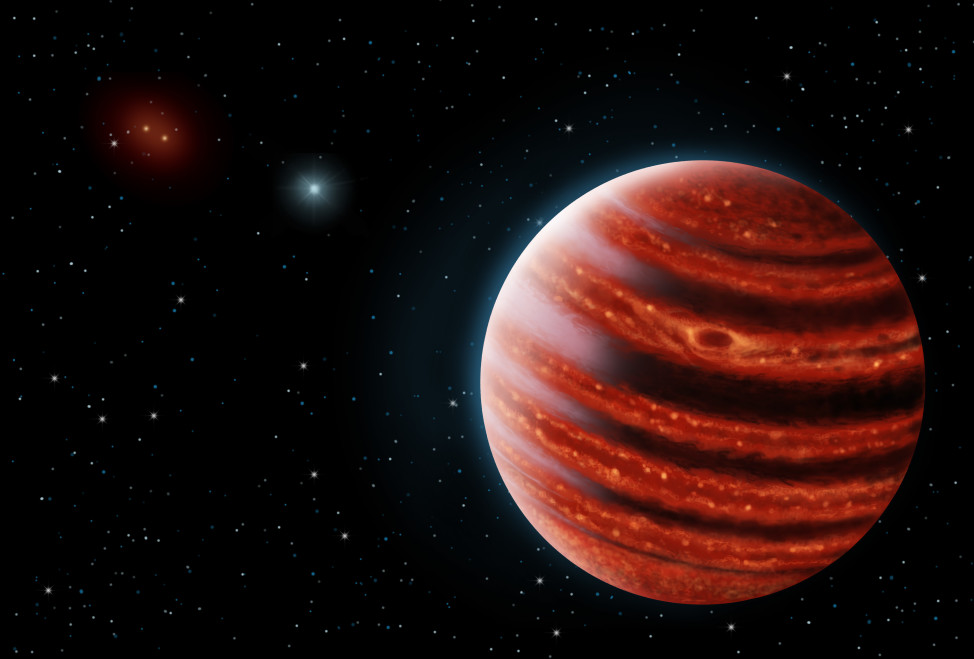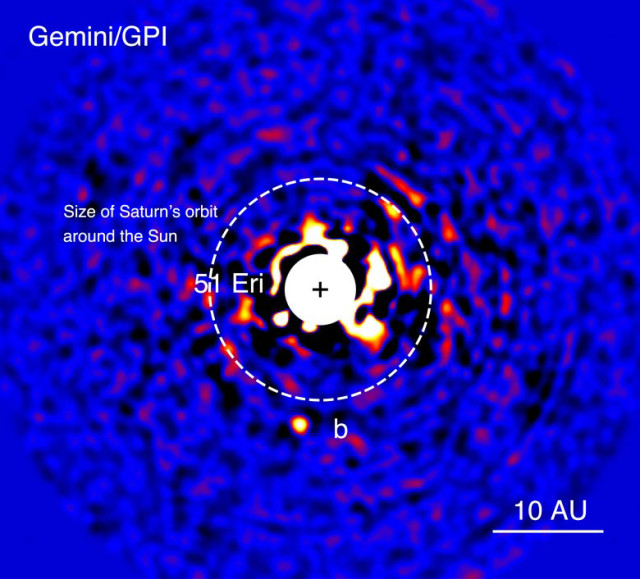
An artistic conception of the Jupiter-like exoplanet, 51 Eridani b (Danielle Futselaar & Franck Marchis, SETI Institute)
A group of scientists have discovered a new exoplanet they say resembles a young Jupiter.
Called 51 Eridani b, the gas giant is about 100 light years away, has twice the mass of Jupiter, orbits its star – 51 Eridani – at a distance comparable to between Saturn and Uranus in our solar system and is a youthful 20 million years old. By comparison, the Earth, Sun and most other objects in our solar system are around 4.5 – 4.6 billion years old.
The scientists outlined their findings in a new paper published in the August 13th online edition of the journal, Science.
“This planet really could have formed the same way Jupiter did; the whole solar system could be a lot like ours,” said the paper’s lead author Bruce Macintosh of Stanford University and the Lawrence Livermore National Laboratory.
The light from this alien planet is very faint to begin with and with its host star glowing about a three million times brighter it would have been difficult to make the discovery without special equipment.

This image of planet 51 Eridani b was taken with the Gemini Planet Imager in near-infrared light in December 2014. (Julien Rameau (UdeM) and Christian Marois (NRC Herzberg))
The scientists were able to pick up on the faint planet and overcome the blinding luminosity of its star by using a specially designed device called Gemini Planet Imager, or GPI.
The GPI can make observations of faint objects because of its ability can mask the light from nearby stars.
The device was installed in 2013 on the 8 meter Gemini South Telescope in central Chile.
Being such a young planet, 51 Eridani b is still releasing a lot of energy and heat from its formation.
Since the GPI can take images over a wide range of wavelengths the scientists were able to directly detect the exoplanet in near infrared light produced by that radiating heat and energy.
The exoplanet has a temperature of about 430°C. While this temperature is incredibly hot and can still melt lead – 327.5°C, the planet is actually kind of chilly compared to other gas giants, that usually have temperatures above 540°C.
The scientists say that this newly found exoplanet is most like a planet from our own solar system that has ever been directly imaged around another star.
Up until this discovery other the only other gas giant exoplanets that had been detected directly were much large in size; between five to thirteen times the mass of Jupiter.
The GPI is also equipped with a newly developed spectrometer that revealed the presence of water and that 51 Eridani b is surrounded by the highest concentration of methane that has ever been detected on an exoplanet. Previously discovered Jovian exoplanets have shown only faint hints of methane.
The scientists say that their discovery could provide valuable clues to help gain a better understanding of how our solar system’s planets formed around the sun billions of years ago.
Discovery of Young Jupiter Exoplanet (Gemini Observatory)






















Comments are closed.